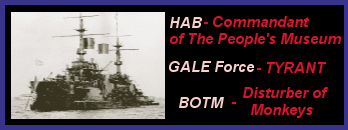It is not joke about Saruman in TTT. He will die. PJ said he would do it because he's going to cut the scouring of the shire out of ROTK.
I don't have a list of all the changes, but I'll give you the article relating to Saruman's death in TTT.
http://www.the11thhour.com/archives/112 ... bits1.html

They call it the Wizard Kabob.
It was only a small picture that appeared on the New Zealand news website Stuff on August 8, 2000, but after nearly three months, it has not ceased to be a hub of controversy. It is discussed over and over in chatrooms, and it has been analyzed time and time again within an inch of its life. It has resulted in jokes, arguments, death threats, and more wild speculation than you can shake a staff at. It has become the symbol of a vast sentiment that is sweeping the ranks of the obsessed...
How dare they change The Lord of the Rings like that?
Truth is, there's no way anyone could make a Lord of the Rings movie that would entirely please the books' enormously rabid fan base (as Ralph Bakshi can surely attest). As a member of said rabid fan base, I can most definitely sympathize. Tolkien's novels have a way of becoming a part of their reader, and those who love them, love them very deeply. And sometimes they get jealous. After all, everyone sees Middle Earth differently, and everyone considers their view to be the definitive one. Legolas has blonde hair! No, black hair! No, blonde hair! No, black hair! Sauron is pronounced SOW-ron! No, it's pronounced SORE-on! Actually, it's sow-RONE. It is not! And so on. I say Balrog wings, you say no wings -- let's call the whole thing off.
We never thought we'd say this, but...damn, those Hobbits sure are fine.
So one can only draw the conclusion that anyone who decides to make a movie based on the books is extremely brave and most likely rather foolhardy. A movie will always be a single perspective on its source material, frozen on celluloid for eternity. Once the movies are made, legions of people who have never read the books will probably take the filmmakers' view of Middle Earth as their own. And so the ardent fans that have been watching the progress of filming with such devotion have been understandably nervous following every dubious announcement. The female roles have been "beefed up"? Sauron is visible? Arwen is being played by Liv Tyler?! The internet trailer released in April was subject to a shot-by-shot breakdown on TheOneRing.net, which is the central location for most of this scrutiny. Fans fretted over a million minute details that the trailer exposed -- why is Boromir handling the ring, why is Arwen carrying Frodo on her horse, why isn't Aragorn standing with the hobbits at Weathertop? Still, these were all small details, and not evidence of any larger changes that might be afflicting the hallowed source material. More than anything, these worries were a chance for debate and something to talk about during the interminable wait for the movies' release.
But the infamous spiked wheel photo was the final straw for many fans. The picture, taken on set, showed an old man of wizardy appearance skewered upside down on a huge spiky ring. Mystified Tolkien lovers everywhere tried to figure out where on earth this could possibly fit into the story. More information came later, when a spy sent in a reported call sheet from that day's filming that identified the impaled figure as the wizard Saruman (Christopher Lee). This is a decidedly gorier end than Saruman met in the books, and many fans irately put it down to the "Jackson Influence."
Before taking on Lord of the Rings, Peter Jackson was best known as a director of outrageous horror comedies. However, a closer look shows that the movies' connections to the horror genre don't stop there.
The Jackson Influence would be Peter Jackson, the films' director. Before taking on one of the most ambitious cinematic endeavors since, say, Intolerance, Jackson was best known as the creator of outrageous horror comedies such as Bad Taste, Braindead, and The Frighteners. Not, perhaps, the first director one would think of in relation to Tolkien's classic fantasy series. However, a closer look shows that the movies' connections to the horror genre don't stop there. There is Lee, of course, one of film's most well known and prolific Count Draculas, now playing the story's most visible villain. The music is being composed by Canadian Howard Shore, who has worked extensively with David Cronenberg as well as creating such classic horror movie scores as Se7en and Silence of the Lambs. John Gilbert, one of the editors, has worked in New Zealand horror films and thrillers throughout his career. Editor Jamie Selkirk and production designer Grant Major are both veterans of many of Jackson's older movies. Not to mention the fact that the movies are being produced by New Line Cinema, the House that Freddy Built. Sure, they've moved up in the world now, but the studio's origins were based in horror franchises such as Critters, Lawnmower Man, and Nightmare on Elm Street.
So what does all this mean for the finished product? How will the influence of all these horror movie types change Lord of the Rings? The Wizard Kabob is only the first sign -- what else will follow?







